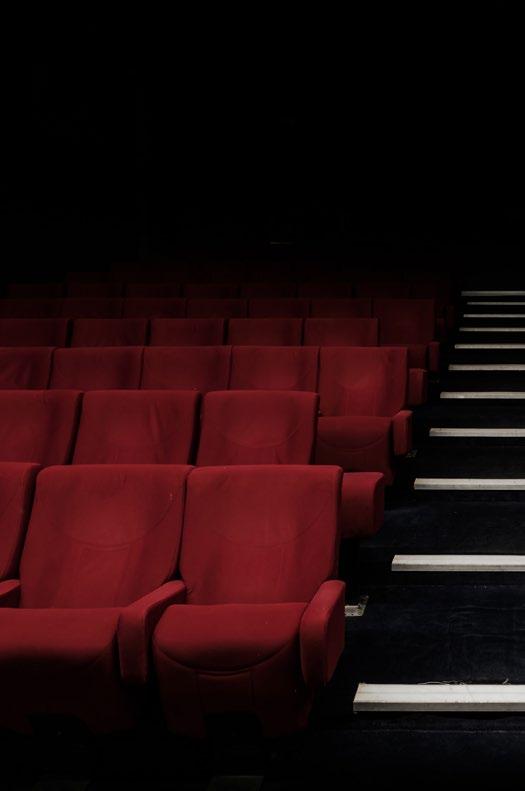
4 minute read
Lights Out
What impact will new approaches to digital content distribution on the ground have on the in-flight entertainment marketplace?
By Tomás Romero
At the height of coronavirus shelter-inplace directives this spring, streaming at home proved to be so hugely popular that Netflix, Amazon Prime Video and YouTube actually reduced their video playback quality in the European Union to help ease the burden on the region’s Internet infrastructure. The situation on the global theatrical front, however, was a much tougher fix.
Opening on March 6 in the US, Disney-Pixar’s Onward had the unique distinction of hitting two lows in the animation studio’s recent history: It had both the worst opening weekend numbers and the worst 10-day opening ever. But the film’s protagonists, the Lightfoot brothers, were hardly alone in their misery. The crushing economic impact of the coronavirus on the industry was exacerbated when theaters in most major markets closed and US box-office tallies virtually zeroed out for the first time in Hollywood history.
Upcoming major studio releases like A Quiet Place Part II, Black Widow, the latest James Bond entry No Time to Die and the live-action Mulan reboot were pushed to mid-summer, fall and, in some cases, even to next year. With film fans homebound, a new plan of action that turned the long-standing 90-day theatrical-to-home rental release window on its head was also needed.
Studios began embracing everything from early releases on video on demand (VOD) – for films like The Invisible Man, Emma, The Hunt and Onward, which hit the VOD market two weeks after it opened in theaters and the studio’s subscription streaming platform, Disney+, two weeks after that – to ticket sales for film screenings at “virtual cinemas” hosted on indie theater websites. Some even began to forgo domestic theatrical releases entirely, as was the case for Universal-Dreamworks’ $90-plus-million Trolls sequel, Trolls World Tour, which had a limited theater release on April 6 and was available for digital rental the same day. And just like that, the future of digital distribution was suddenly wide open.
But Universal-Dreamworks’ leap was not without consequence: AMC Theatres responded by saying it would stop screening the studio’s films altogether. Meanwhile, the movie raked in $100 million in rental fees after having been available online for about 20 days. NBCUniversal CEO Jeff Shell said the digital release exceeded expectations and showed viability for VOD.
KATE GROTH, WEST ENTERTAINMENT
“Whichever distribution model the entertainment community embraces moving forward, it will need to recoup massive investments,” says Kate Groth, president of West Entertainment. However, should a premium direct-toconsumer window emerge, this would not necessarily impact how studios offer films to airlines, she says: “We see it in our data analytics. Major box-office hits like Avengers: Endgame grossed over $2.8 billion worldwide and still performed extremely strongly across airlines when it became available. Not everyone has the time to watch everything on the ground.” The biggest change to the post-pandemic in-flight entertainment space won’t be content distribution, Groth explains, but budgets. Branding.aero founder and president Stathis Kefallonitis seems to agree, saying that after COVID-19, content streaming may become more popular with airlines – but as a cost-cutting measure. “We may still find seatback entertainment in premium cabins, but in economy class, things will change.”
The coronavirus outbreak offers an opportunity to rethink current approaches, especially for younger audiences whose views on accessing content at home, on the go and even on an airplane, may be further shaped by the lockdown. “Even before the isolation period, social media played a key role in the success of movies and TV shows by engaging with fans and promoting new content to targeted audiences,” says Groth. “Connectivity on board will provide greater flexibility to leverage personal devices and offer more personalized content options.”
Another question sure to be on the minds of many in the creative community right now is how to tackle the global pandemic on screen in the months and years ahead. Although there is no direct modern-day equivalence, after 9/11, Hollywood took a hard and fast break from making films with themes and imagery that might upset viewers. Shots of the World Trade Center’s twin towers, for instance, were digitally removed from dozens of television shows and films like Zoolander, Stuart Little 2 and Spider-Man.
But the reaction to the pandemic from the present-day entertainment industry already feels markedly different, with talk show hosts, celebrities and even SNL taking to the Internet during the lockdown to produce content from home. “Everyone is looking for greater human connection and escapism right now,” says Groth, adding that humor has an important role to play.
Meanwhile, virus-related thrillers, like Outbreak and Contagion, have seen significant upticks in popularity, and R.E.M.’s 1987 hit “It’s the End of the World as We Know It (And I Feel Fine)” rejoined the iTunes Top 100 chart. Such developments reinforce the fact that we are all in search of stories that make sense of these unprecedented times.









